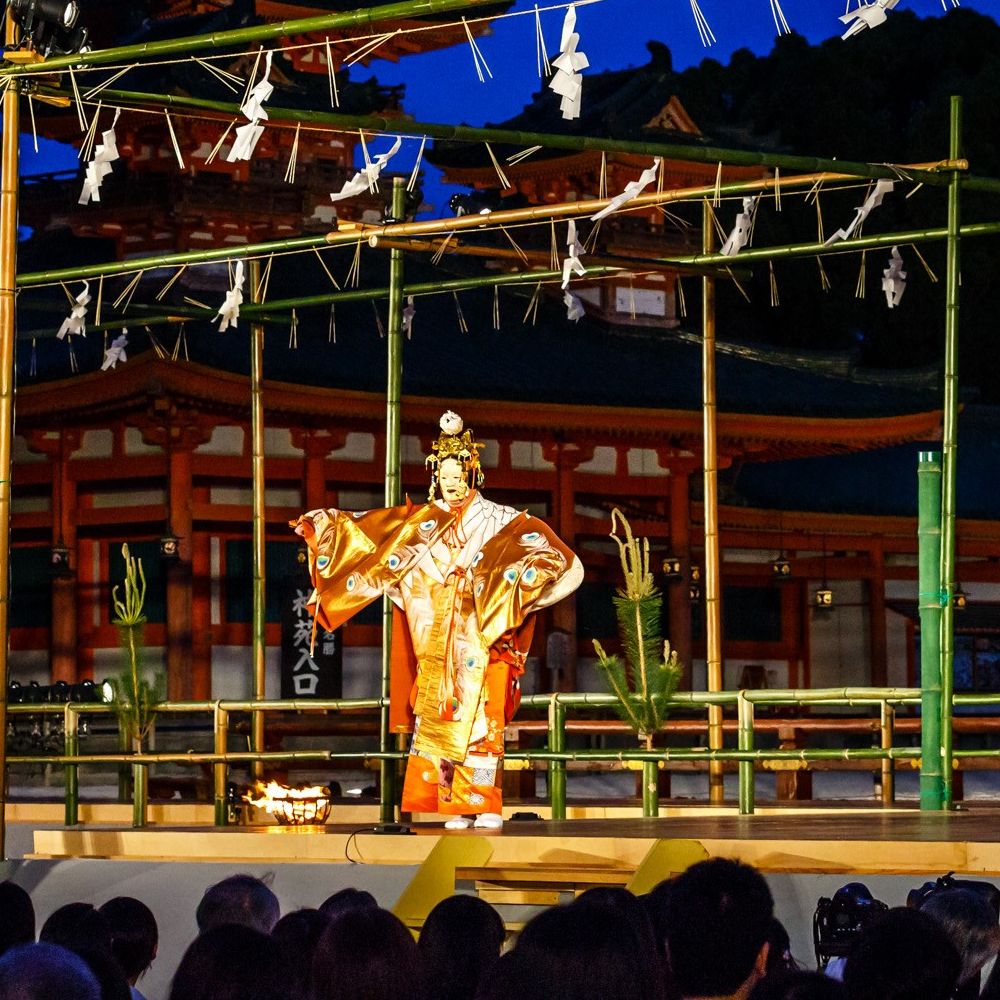Takigi Noh is a traditional Japanese open-air theater performance that takes place every year at the Heian Shrine in Kyoto. This unique event offers an immersive experience in Japanese history and culture, attracting spectators from around the world.
Origins and Characteristics of Noh
Noh is a form of Japanese theater art that dates back to the 14th century. Characterized by slow, graceful movements, subtle facial expressions and poetic storytelling, Noh is distinguished by its minimalist and spiritual aesthetic. The actors are adorned with elaborate costumes and hand-carved masks. They play various characters such as gods, warriors and ghosts. This form of theater is known for its contemplative atmosphere. But also for its commitment to representing the ephemeral beauty of life.
The Concept of Takigi Noh
Takigi Noh, literally “Noh at the campfire”, is an open-air version of Noh theater. It is, as its name suggests, carried out around a campfire. The flames illuminate the actors, creating a magical and mystical atmosphere that transports spectators to another dimension. This open-air setting adds a natural and elemental dimension to the performance. It accentuates the ritual and spiritual aspect of Noh.
The Heian Sanctuary: An Ideal Setting
The Heian Shrine is one of the most emblematic places in Kyoto. It was built to commemorate the 1100th anniversary of the founding of the city. With its vast gardens and impressive Shinto-style architecture, the shrine provides an ideal setting for Takigi Noh. The grandeur and tranquility of the place enhance the experience. They allow spectators to fully immerse themselves in the mystical atmosphere of the show.
The Annual Event
Takigi Noh takes place every year at the Heian Shrine for three consecutive nights. Usually at the end of June. Tickets for this event are very popular. Booking is important due to the popularity and unique appeal of the show.
Program of the Evening
The evening begins with a procession of actors dressed in traditional costumes, crossing the sanctuary gardens illuminated by lanterns. This solemn entrance prepares spectators for a journey through time. Once on stage, the actors begin the performance. Musicians accompany them, playing traditional Japanese instruments such as the shamisen, flute and drum. The flames of the campfire crackle and cast dancing shadows, adding a haunting visual dimension to the story being told.
The precise and graceful movements of the actors, combined with the poetic narration and traditional music, captivate the audience. Its campfire, a central element of the setting, intensifies the mystical atmosphere. This creates a deep connection between nature and art.
An Unforgettable Experience
Attending Takigi Noh is an unforgettable experience for anyone interested in traditional Japanese culture. This unique show not only offers insight into the history and art of Noh. But it also allows spectators to experience a magical evening in the heart of the Heian sanctuary. The combination of historic architecture, serene gardens, theatrical performance and the natural element of the campfire creates an enchanting ambiance that remains etched in the memory of each participant.
For those seeking to discover the richness of Japanese culture, Takigi Noh is an invitation to delve into a world where history, art and nature intertwine harmoniously.



